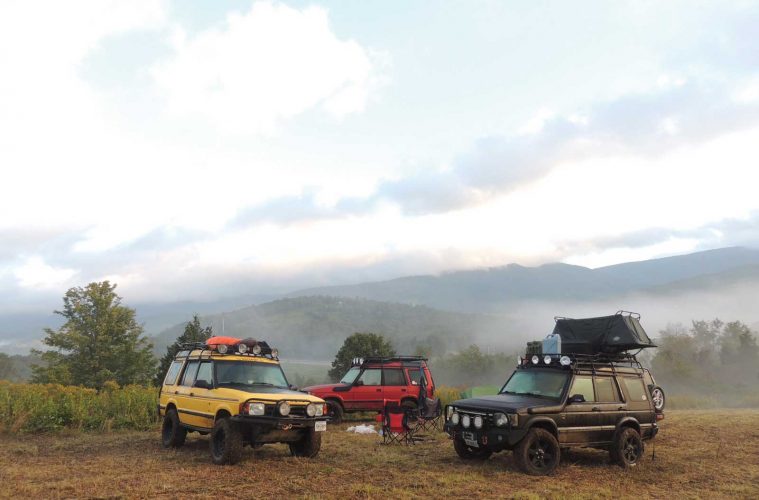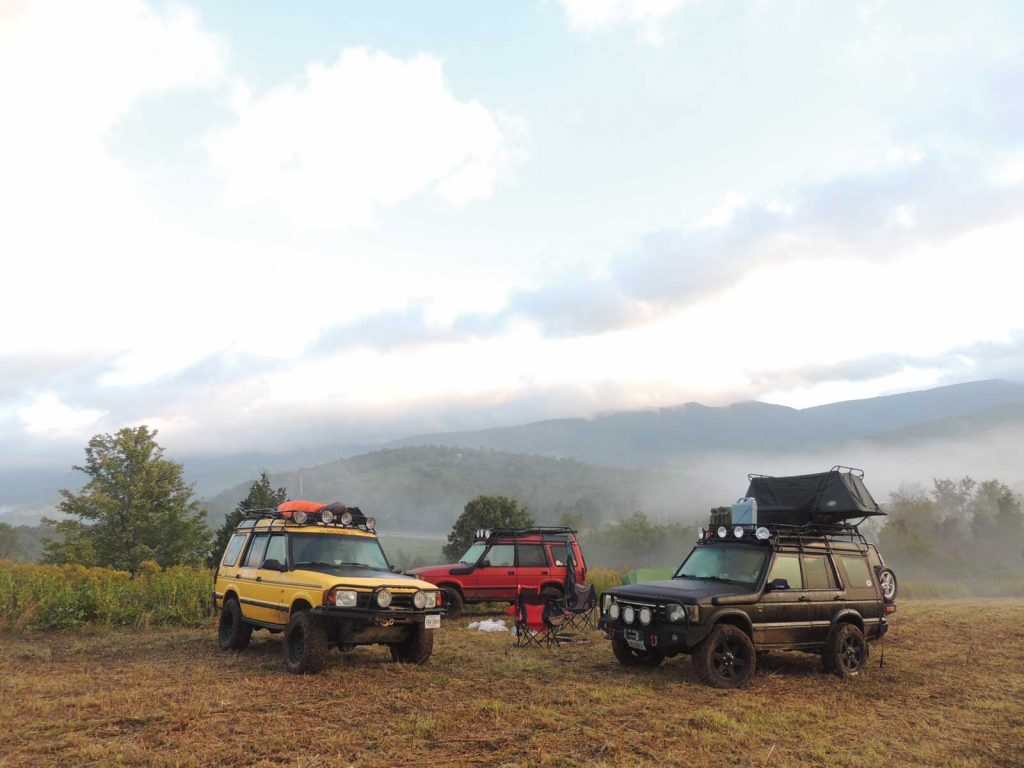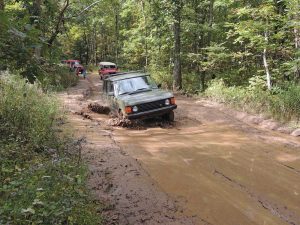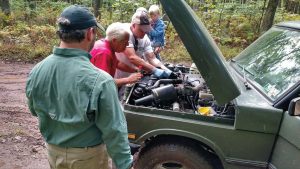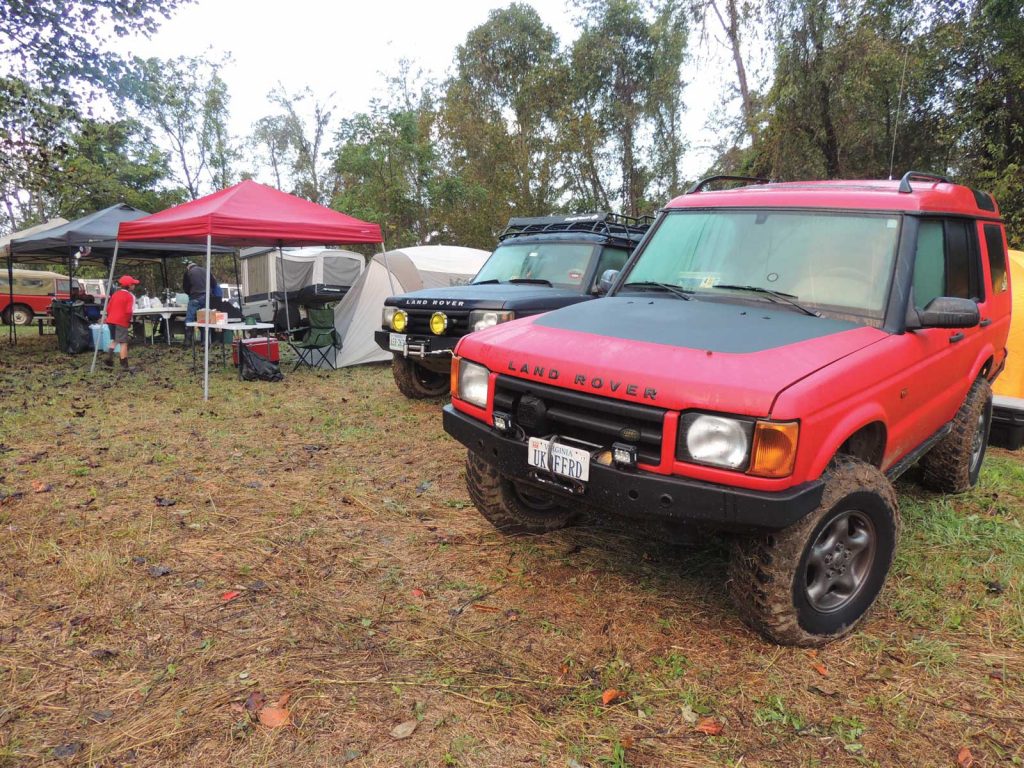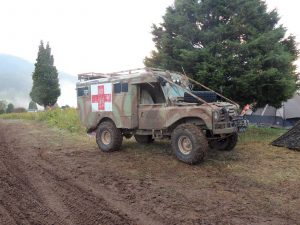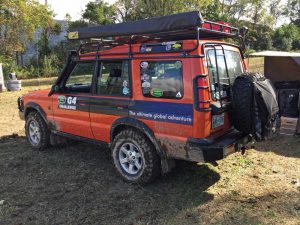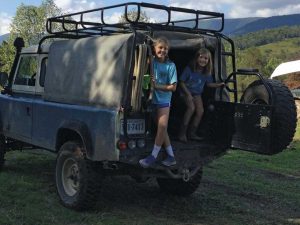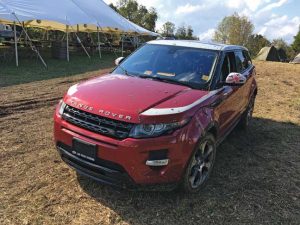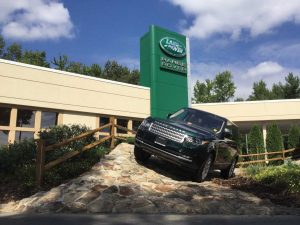Shane Stoehr pointed his ‘91 Range Rover Hunter towards the water hole and gunned it. Halfway through it stopped as a wave of water entered through the grill. He grinned sheepishly as Len Fagan, Floyd, VA and I sprayed WD-40 over the distributor cap and wiped down the coil wire. “Rookie mistake,” he said, as he fired up the engine and proceeded out.
As one of the oldest consecutive events in the US, the Mid Atlantic Rally has always been held during the first weekend of October. The fact that the same weekend coincides with the East Coast hurricane season has never stopped soggy enthusiasts from having a spectacular time. It didn’t slow this year’s 100-plus Land Rovers, either.
This 22nd event took place at the Wheatland Farm property of Land Rover enthusiast Sam Moore. Its 700 acres rises across two sets of verdant hillsides, bisected by a two-lane road. On one side the terraced land provided ample room for the hundreds of campers; on the other side, over 20 trails, ranging from greenlane fire roads to extreme “you-might-break-something” cuts through the woods. Adding to the fun, Rovers North once again sponsored the RTV Trials Course, a challenge that tested enthusiasts’ knowledge of their vehicle’s capabilities and limits.
For months prior to the event Trailmaster Michael T. Boggs had pulled together volunteer crews to clean up existing trails and create new ones. With the help of Bob Steele, Jeff Bang, David Short, Kevin Smith, David Powers, Larry Mitchell, Mike McCaig and other volunteers, the crew spent many weekends with chainsaws, loppers and weed-whackers to push back brush, move blown down trees and take down branches that would otherwise inevitably latch onto roof racks. The work was arduous, but well worth it, particularly in light of the slickness of the trails due to the week’s rains.
Ah, yes, the rain… some wags insist that the acronym MAR stands for “Mud And Rain.” This year’s event featured deluges on Thursday and Friday, but a welcome sun and winds changed everything for Saturday and Sunday. That boosted everyone’s spirits as tents, Land Rovers and clothing dried out. The initial rains quickly turned the entry and registration areas into a quagmire, making it difficult for Land Rovers towing trailers to ascend the hillside; many wound up camping on the lower levels. With some careful driving and proper applications of wellie, less-burdened Land Rovers could make it to the favored camping sites on higher ground.
I weighed my travel options between a 14-plus hour drive in my Series II-A, versus a 2.5-hour flight and a 235-mile drive from Richmond, VA, to Giles County, VA, in a Range Rover Evoque, courtesy of event sponsor Land Rover Richmond. Given the stunning scenery of the Blue Ridge Mountains and the comfort of the Evoque, it wasn’t much of a contest.
Arriving at the event site on Friday afternoon revealed the difficult conditions. A light drizzle fell and thick, gumbo mud covered much of the lower area—it took on the look of a rebel encampment in an apocalyptic Syfy channel movie. Dogs romped and got filthy, chased by kids of all ages enjoying the conditions. Those who had tackled the trails on Thursday and Friday rendered all their Land Rovers the same shade of brown. An impressive array of license plates told you that enthusiasts had come from neighboring states and regions to enjoy the event.
For those who feared no damage because they feared no off-road evil, Michael Boggs organized his annual rock climbing competition. Morning, afternoon and night rides were well organized, but trail conditions deteriorated as the rainwater flowed over the steep trails and left plenty of mud in its wake. Some conditions warranted significant winching and recovery, while others offered impromptu water crossings. Most of the trails ran through forested land, but every so often, a clearing would reveal the vistas that make this part of Virginia so breathtaking. There was plenty of slippery rock, narrow trails, mud holes and water to excite the novice and experienced off-roader alike.
Rovers North sponsored the annual RTV trials course and tasked me with creating it. A trials course relies on the driver’s knowledge of their Land Rover and its capabilities, with the only possible damage being to their ego. You navigate through a series of narrow gates, each numbered consecutively, that twist, turn, climb and descend—and you do so without stopping or reversing (Defender 110’s were permitted one shunt [stop and turn] per section). Touch a pole, miss a gate, stop and/or reverse and you receive the penalty points indicated on the flag atop the pole. The driver with the lowest point total wins the event. For this event we created five sections, each with six sets of challenges.
This year, ROAV president Bob Steele and MAR organizer David Short determined that the course location would be changed (otherwise my life would have been too easy). They selected a dry, grassy hillside, which gave plenty of opportunity for tight turns on side slopes, ascents, descents, and after a lot of tromping around the grounds, hidden holes and moguls. Fortunately, I recruited the additional assistance of Trevor Griffiths, Hershey, PA and his dog, Luna, Neil Hanekom, Fleetwood, PA and Joe Jimenez, Perisburg, VA, all of whom spent four hours designing, laying out and pounding in poles for the course. Trevor’s Range Rover Classic was used for testing the initial layout, with some changes made after trying the course in a longer Discovery II.
It took two hours for nearly 50 entrants to test their off-road driving skills, and in some cases, the considerable driving talents of their children. Once again, additional volunteers stepped forward to help marshal the individual sections. The penalty point total reached a high of 71, with only four contestants able to get below 15. The winner this year was Michael T. Boggs, in a ‘94 Discovery I, with zero penalty points. Second place went to Loïc Fabio in his ‘95 Defender 90. Mike Seward, in an ‘89 Defender 110, and Bo Prillamen in a ‘96 Discovery I, rounded out the lowest scores.
ROAV has always received generous support from sponsors and their gifts become items for a raffle and auction, with the funds going to subsidize the total cost of the event. President Bob Steele noted the role of sponsors in keeping the individual costs down to a reasonable level; at $100 for four days of camping with facilities, organized off-roading and Land Rover swag, it’s a great deal. David “Fireman” Short once again did a sterling job as the MC and auctioneer, with the colorful assistance of Robert Davis. Blue Mountain Catering gave the assembled campers a night off from cooking, filling bellies with a terrific BBQ dinner.
MAR brought kids, spouses, significant others and friends together for a joyous weekend, and introduced new enthusiasts to the larger Land Rover community. The range of Land Rover models extended back to Series II- A’s and Australian military Perentie’s, to the newest Range Rovers.Many carried new enthusiasts to their first MAR. I’ve no doubt that many will return next year—just plan on bringing rain gear.
Land Rover Richmond
Thanks to the courtesy of Land Rover Richmond, whose banner at MAR signaled their continued support, a Range Rover Evoque Dynamic became my transportation for the event. Land Rover has stated it wants each of its models to sit in the “premium” category of every market, and the Evoque does this brilliantly.
As the top of the line Evoque, the HSE Dynamic features an interior packed with functional luxury. Push a button to move the headliner back and the panoramic roof delightfully brightens up the interior. The form-fitting seats have infinitely adjustable settings to accommodate all but the tallest of drivers; several different-sized enthusiasts got in and out of it and pronounced it roomier than it looked. They’re also hugely comfortable—I never felt fatigued during the 4-hour drive. The navigation, entertainment and climate systems all worked at a premium level. My favorite music sounded terrific, and the navigation system guided me effectively and seamlessly synced with my phone.
The 2.0 L 4-cylinder turbocharged engine might seem small in specifications, but it’s not small in performance. The 240 hp engine offers 250 lb ft of torque at 1750 rpm with a 9-speed automatic; the Sport mode takes every shift to the redline. The drivetrain tracked sure and true in wet or dry conditions, whether interstate or two-lane mountain roads with plenty of curves.
Of greater interest were its capabilities on muddy fields and hills. The entry area to the MAR campgrounds had been churned up and rendered very slick by steady rain and large tires; the Evoque comes standard with low-profile, high speed tires, and only 8.4 inches of ground clearance. Your removable spoiler and wheel well trim of some miracle material will be endangered by ruts and mud, even though its brilliant electronic traction aids and proper throttle techniques will push you through conditions that stymied some earlier Land Rover models. As with other contemporary Land Rovers, you get little feedback through the throttle pedal or steering wheel [2.3 turns lock to lock on the Evoque], but be patient and let the Land Rover do its stuff and you’ll get through anything—to the amazement of onlookers. When heading downhill, the Hill Descent system helped keep the Evoque fully in control.
With a wheelbase of only 104” (172” overall length) and little overhang, it has a 25-degree approach angle and a 33-degree departure angle [that spoiler again], it’s quite maneuverable in tight spaces and you can really sense the edges of the vehicle. Unlike the Discovery Sport, however, you can’t fold down the middle seats to gain more space for gear.
Land Rover never promoted it, but some significant enhancements to the four-wheel drive occurred around the 2014 models, making them even more capable in tough conditions. When you can get 30 mpg on the highway [24 overall], it will be easier to enjoy more time off-road.
By Jeffrey Aronson
Photos: David Short, Jeffrey Aronson, Loic Fabro
